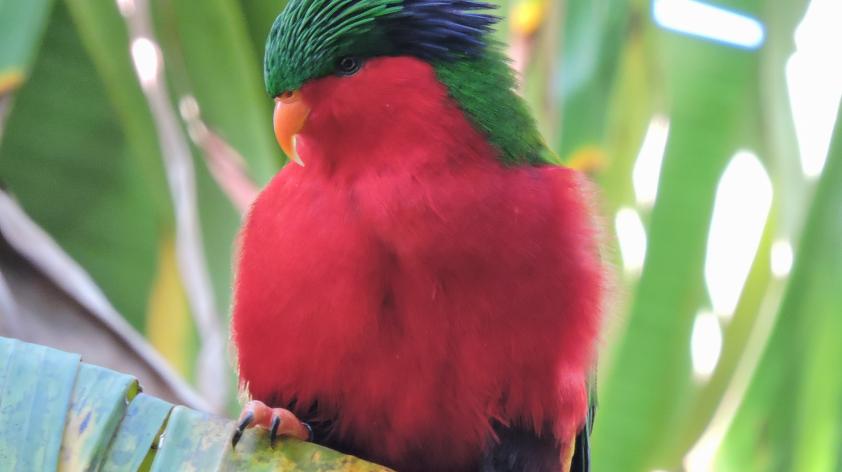
Where are they now?
Have you ever wondered what ever became of an old friend or favorite celebrity? That's kind of how Alan Lieberman and I felt as we returned to the island of Atiu in the Cook Islands to check on the status of a small population of Rimatara lories.
Back in 2007, we were recruited by Gerald McCormack of the Cook Islands Natural Heritage Trust to assist with the translocation of 27 Rimatara lories from the island of Rimatara in French Polynesia to Atiu in the Cook Islands, and now we were going back to see how they were doing.
The Rimatara Lory at one time was distributed throughout French Polynesia and the Cook Islands, but after the arrival of the Polynesians, the birds were gradually extirpated from each island until there was only one remaining population – on the tiny island of Rimatara, which is only about a mile and a half in diameter. These birds are relatively small and incredibly beautiful, with bright red, blue, green, and yellow feathers. Unfortunately, those red feathers led to their demise on most of the islands they inhabited. The Polynesians collected them in large numbers for those red feathers, which were used to decorate ceremonial headdresses.
The birds survived on Rimatara partly because it was such a small and remote island, but also because Queen Tamaeva IV placed a taboo on collecting them back in the late 1800s. Whether her motive was to preserve the birds for future generations or to maintain exclusive rights to their feathers is not really known, but the end result was the same – the survival of this beautiful bird on a remote outpost in French Polynesia.
Gerald realized that the bird was vulnerable to extinction if the ship rat (Rattus rattus) was ever introduced to the island, or if the island took a direct hit from a typhoon. So for more than a decade he had worked on a plan to establish a second population in their historic range as a hedge against extinction. As it turned out, Atiu was the only suitable island in the bird's historic range that was still free of the ship rat. The people of Atiu were overjoyed at the possibility of the return of the lory, which they called the Kura, but it took quite a bit of diplomacy to negotiate the international transfer. The government agencies in the Cook Islands and French Polynesia had rarely dealt with such a scenario, and the people of Rimatara were concerned about violating Queen Tamaeva's taboo, which is still in place!
In the end, Gerald's persistence paid off and the translocation was scheduled for April 2007. Gerald recruited Alan Lieberman to help because of his experience doing similar translocations of other lories in the South Pacific, and Alan recruited me because of my experience doing disease risk analyses and health assessments for such translocations. The capture of the birds on Rimatara, the health screens, and the translocation came off flawlessly. After giving each bird a dose of nectar and releasing it on Atiu our job was largely done and we were left with the difficult task of participating in endless feasts and celebrations for the next seven days.
Although we had received periodic updates from the people of Atiu indicating that the lory population was increasing, we decided that after nine years it was time to return to Atiu to see how the birds were doing. The plan was to conduct transect surveys each morning, counting birds to get a population estimate, and attempt to capture some birds by mist net in the afternoon for health assessments. Although we did not capture as many birds as we had hoped, any disappointment was completely eclipsed by our excitement at the number of birds we were counting each morning. In just nine years, the Rimatara Lory has become one of the most abundant birds on the island! Gerald is still compiling and analyzing the survey data, but our best guess is that there are now 300 – 500 birds there.
We were tremendously satisfied as we relaxed at Gerald's house on Rarotonga after completing two weeks of surveys, but the best part of the trip was yet to come. As Alan was downloading his photos to Gerald's computer, I heard him yelling excitedly for me come quickly. When I got to Gerald's office, there on his computer was a beautiful photo of a Rimatara Lory that Alan had taken the previous day, our last day on Atiu. As we looked closely, we could see that the bird had a band on each leg. We had only placed bands on both legs during the original translocation, which meant that this bird was one of the original 27 we had translocated nine years earlier, and it was still alive and thriving after all these years!
We had wondered how many of the original birds were still alive, but with the population so large now we thought the chances of finding one of the original birds were pretty slim, but there it was. The feeling was like seeing an old friend after many years, and being happy to see how well they were doing. Conservation programs are often challenging and outcomes are not always clear-cut, but this one can only be described as a spectacular success.













